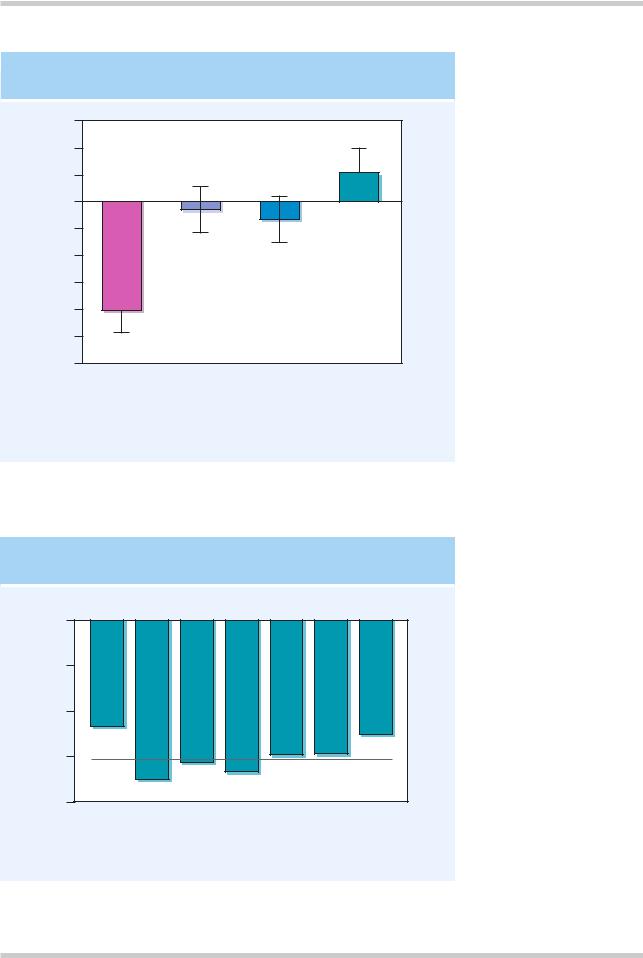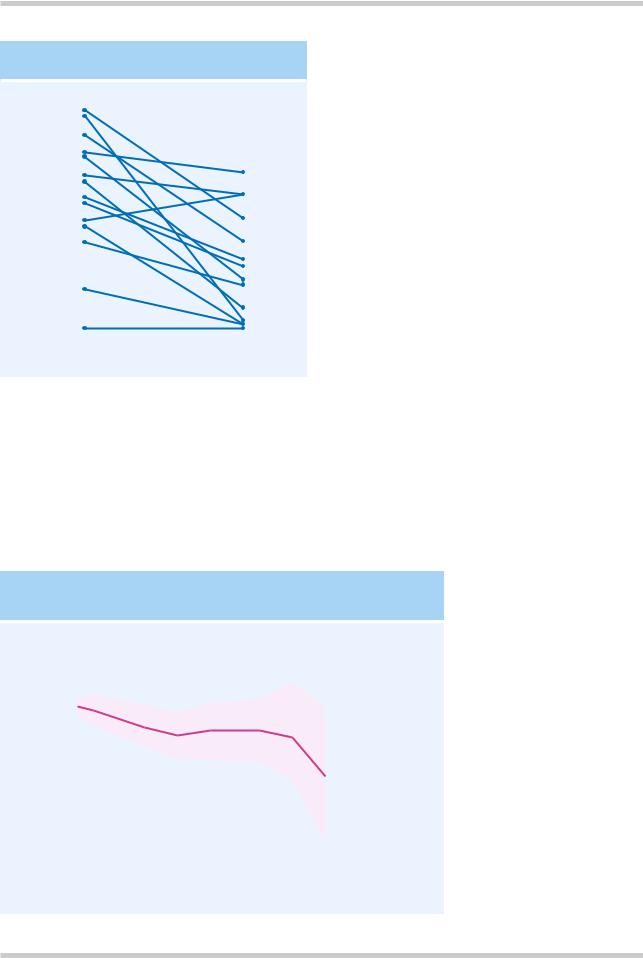
- •Contents
- •Other atlases in this series include:
- •Preface
- •Foreword
- •History and Classification
- •The Acute Illness
- •The Chronic Illness
- •Factors Affecting Prognosis
- •References
- •Genetics
- •Environmental Influences
- •Early Environmental Factors
- •Obstetric Complications
- •Prenatal Infection
- •Neurodevelopmental Abnormality
- •Later environmental factors
- •Substance Misuse
- •Social and Psychological Factors
- •Conclusion
- •References
- •Structural Imaging and Anatomical Studies
- •Functional Brain Imaging
- •Neurochemistry
- •Neuropsychology
- •Psychophysiology
- •References
- •Introduction
- •Classification of Antipsychotics
- •Neurochemistry of Schizophrenia and Mechanisms of Action of Antipsychotics
- •Dopamine
- •Serotonin
- •Other Neurotransmitters
- •Efficacy of Antipsychotics in the Acute Phase of Treatment
- •Pharmacotherapy as Maintenance Treatment in Schizophrenia
- •Low-Dose Antipsychotics
- •Intermittent or Targeted Medication
- •Acute Neurological Side-Effects
- •Medium-Term Neurological Side-Effects
- •Chronic Neurological Side-Effects
- •Neuroendocrine Effects
- •Idiosyncratic Effects
- •Cardiac Conduction Effects of Antipsychotics
- •Clozapine
- •Risperidone
- •Olanzapine
- •Quetiapine
- •Amisulpride
- •Ziprasidone
- •New Antipsychotics Currently in Phase III Clinical Trials
- •Iloperidone
- •Aripiprazole
- •Negative Symptoms
- •Cognition
- •Affective Symptoms
- •The Future
- •References
- •Psychological Therapies
- •Cognitive Behavioral Therapy
- •Neurocognitive Remediation
- •Compliance with Drug Treatment
- •Family Treatments
- •Early Intervention
- •Managing Schizophrenia in the Community
- •References

FUNCTIONAL IMAGING OF FORMAL THOUGHT DISORDER IN SCHIZOPHRENIA
Figure 3.15 PET data have been mapped onto a normal magnetic resonance image of a brain in standard stereotactic space, sectioned to provide transverse, coronal and sagittal views. The left side of the brain is shown on the left side of the image. The images show positive correlations between the severity of positive thought disorder and regional cerebral blood flow at the junction of the left parahippocampal and fusiform gyri (marked by cross hairs), and in the anterior part of the right fusiform gyrus. Figure reproduced with permission from McGuire PK, Quested DJ, Spence SA, et al. Pathophysiology of ‘positive’ thought disorder in schizophrenia. Br J Psychiatry 1998;173:231–5
patterns of correlation in brain activity between different brain areas, giving rise to the concept of functional dysconnectivity, the idea that there is impaired integration of cortical activity between different areas of the brain, rather than a specific focal abnormality or group of abnormalities.
NEUROCHEMISTRY
The primary neurotransmitters implicated in the pathogenesis and treatment of schizophrenia are dopamine and serotonin. Recent theories have also implicated glutamine and γ−aminobutyric acid (GABA). The neurochemistry of schizophrenia is discussed fully in Chapter 4.
PSYCHOPHYSIOLOGY
A crucial research problem in the etiology of schizophrenia is the difficulty in confidently defining a phenotype. One of the main goals of psychophysiological research in schizophrenia has been to identify trait markers that might identify people vulnerable to developing the disorder even if they are asymptomatic.
Two promising trait markers have emerged. Eye tracking disorder, i.e. abnormalities of smooth pursuit eye movements, have been described in
people with schizophrenia and their relatives. Abnormalities in the auditory evoked potential have also been described, e.g. diminished amplitude and increased latency in the P300 response to an ‘oddball’ auditory stimulus, which appears to show both trait and state abnormalities (Figures 3.16 and 3.17)12.
NEUROPSYCHOLOGY
Various theories propose mechanisms that link abnormal neuropsychology in schizophrenia to its symptoms, and the functional neuroimaging techniques described above have begun to provide an important tool in beginning to unravel these relationships. For example, schizophrenic symptoms may arise from faulty attentional processes or ‘central monitoring’, and, as a result, the capacity to distinguish between internal and external stimuli may be impaired (leading, for example, to the experience of hallucinations). Disorders of volition, which are clearly important at the clinical level, may also have specific neuropsychological substrates. Understanding the relationships between symptoms, cognitive function and neurochemistry has become an important new goal in researching the mechanisms of drug action.
©2002 CRC Press LLC

AUDITORY EVENT-RELATED POTENTIALS
–5 V
Amplitude
+5 V |
|
|
|
|
P300 |
|
|
|
|
|
|
|
|
10 |
100 |
1000 |
||||
Stimulus |
Time (msec) |
|
|
|||
onset |
|
|
|
|
||
Figure 3.16 Abnormalities in evoked potentials have consistently shown abnormalities in schizophrenia. The P300 auditory event-related potential (ERP), seen here as one of several components of the auditory ERP, is seen as a response to ‘oddball’ or unexpected stimuli, and shows robust changes in both amplitude and latency in schizophrenic patients and their relatives.
Mean latency
P300 LATENCY IN SCHIZOPHRENIA
0.50
0.45
0.40 |
|
|
|
|
0.35 |
|
|
|
|
0.30 |
|
|
|
|
–FH |
–FH |
Controls |
+FH |
+FH |
schizophrenics |
relatives |
|
relatives |
schizophrenics |
Figure 3.17 These data suggest an increased P300 latency in patients with schizophrenia and their relatives when there is a strong family history of schizophrenia (+FH), but not in sporadic cases (–FH). P300 latency may be an important trait marker for the genetic vulnerability to schizophrenia. Figure reproduced with permission from Frangou S, Sharma T, Alarcon G, et al. The Maudsley Family Study, II: Endogenous event-related potentials in familial schizophrenia. Schizophr Res 1997;23:45–53
©2002 CRC Press LLC

PREMORBID IQ IN PATIENTS WITH
PSYCHOSIS AND THEIR RELATIVES
|
6 |
|
|
4 |
|
|
2 |
|
IQ |
0 |
|
|
||
Premorbid |
–2 |
|
–4 |
||
–6 |
||
|
||
|
–8 |
|
|
–10 |
|
|
–12 |
Patients with |
Relatives of |
Patients with |
Relatives of |
schizophrenia |
patients with |
affective |
patients with |
|
schizophrenia |
psychoses |
affective |
|
|
|
psychoses |
Figure 3.18 Deficits in premorbid IQ (as measured by the National Adult Reading Test) are seen in people with schizophrenia, but not in their first-degree relatives, or patients or relatives of patients with affective psychoses. The zero line is that of normal controls. Figure reproduced with permission from Gilvarry C, Takei N, Russell A, et al. Premorbid IQ in patients with functional psychosis and their first-degree
relatives. |
Schizophr |
Res |
2000;41:417–29 |
|
|
NEUROPSYCHOLOGICAL PERFORMANCE IN SCHIZOPHRENIA
|
0.0 |
|
|
|
|
|
|
–0.5 |
|
|
|
|
|
score |
–1.0 |
|
|
|
|
|
Z |
|
|
|
|
|
|
|
|
|
|
|
|
|
|
–1.5 |
|
|
|
|
|
|
–2.0 |
|
|
|
|
|
|
Language |
Memory |
Attention |
Executive |
Motor |
emorbid |
|
|
isuospatial |
Pr |
|||
|
|
|
|
|
V |
|
Figure 3.19 Profile of neuro-
psychological performance |
of |
||
patients |
with |
schizophrenia. |
|
The |
deficits |
seen |
in |
schizophrenia are not uniform, but they encompass both executive function and memory. The zero line is the score of normal controls. Figure reproduced with permission from Bilder RM, Goldman RS,
Robinson |
D, |
|
et |
al. |
Neuropsychology |
|
of |
first- |
|
episode schizophrenia: |
initial |
|||
characterization |
and clinical |
|||
correlates. |
Am |
J |
Psychiatry |
|
2 0 0 0 ; |
1 |
5 |
7 : |
|
549–59 |
|
|
|
|
©2002 CRC Press LLC

SCORE ON WISCONSIN CARD SORT TEST
|
10 |
|
|
|
|
|
|
|
9 |
|
|
|
|
|
|
|
8 |
|
|
|
|
|
|
|
7 |
|
|
|
|
|
|
Score |
6 |
|
|
|
|
||
5 |
|
|
|
|
|
||
|
4 |
|
|
|
|
|
|
|
3 |
|
|
|
|
|
|
|
2 |
|
|
|
|
|
|
|
1 |
|
|
|
|
|
|
|
0 |
|
|
|
|
|
Unaffected |
Affected |
|
|
twin |
twin |
Figure 3.20 |
Wisconsin |
card sort test (WCST) in |
monozygotic twins discordant for schizophrenia. The WCST is a measure of executive function. In twins discordant for schizophrenia, performance on the WCST is uniformly impaired in the affected twin. Data from Goldberg TE, Torrey EF, Bigelow LB, et al. Genetic risk of neuropsychological impairment in schizophrenia: a study of monozygotic twins discordant and concordant for the disorder. Schizophr Res 1995:17:77–84
The cognitive deficits seen in schizophrenia include lower premorbid IQ (Figure 3.18)13, as well as more circumscribed deficits, for example in memory and executive function (Figures 3.1914 and 3.2015). These are almost certainly a primary feature of the disorder.
Some neuropsychological deficits are present long before the onset of schizophrenia. Two large cohort studies from the UK have supported the idea that the deficits of schizophrenia may be apparent early in life, with evidence of impaired educational test performance and avoidant social behavior (Figure 3.21)16. Childhood ‘schizoid’ personality traits may reflect deficits in cognition and in social behavior that are part of the disease process itself. Abnormalities of social behavior, movement and posture have also been reported (for example, in studies based on old home movies of affected and unaffected siblings). The antecedents of schizophrenia may therefore become identifiable long before the clinical onset of the illness.
TRAJECTORY OF PREMORBID IMPAIRMENT
|
2 |
|
|
|
|
|
|
|
|
|
|
|
|
|
|
|
|
|
|
|
|
|
|
|
|
|
|
controls |
1 |
|
|
|
|
|
|
|
|
|
|
|
|
|
|
|
|
|
|
|
|
|
|
|
|
||
0 |
|
|
|
|
|
|
|
|
|
|
|
|
|
from |
|
|
|
|
|
|
|
|
|
|
|
|
|
–1 |
|
|
|
|
|
|
|
|
|
|
|
|
|
|
|
|
|
|
|
|
|
|
|
|
|
||
–2 |
|
|
|
|
|
|
|
|
|
|
|
|
|
Deviance |
|
|
|
|
|
|
|
|
|
|
|
|
|
–4 |
|
|
|
|
|
|
|
|
|
|
|
||
|
–3 |
|
|
|
|
|
|
|
|
|
|
|
|
|
–5 |
|
|
|
Mean |
deviance |
|
|
|
|
|
|
|
|
|
|
|
|
|
|
|
|
|
|
|||
|
|
|
|
|
|
|
|
|
|
|
|
|
|
|
|
|
|
95% Confidence |
interval |
|
|
|
|
|
|
|
|
|
–6 |
|
|
|
|
|
|
|
|
|
|
|
|
|
|
|
|
|
|
|
|
|
|
|
|
|
|
|
0 |
5 |
10 |
15 |
20 |
||||||||
Age in years
Figure 3.21 The study of large birth cohorts provides a powerful tool for investigating risk factors in schizophrenia. In the 1946 UK birth cohort16, risk factors for later schizophrenia included problems at play, few friends, inappropriate emotional expression, anxiety, impaired intellectual function and odd movements. Figure reproduced with permission from Jones P, Rodgers B, Murray R, Marmot M. Child development risk factors for adult schizophrenia in the British 1946 birth cohort. Lancet 1994;344:1398–402
©2002 CRC Press LLC
